
Squat is Not Normal
11/22/2013
Your truck is rated to handle what you’re towing. You made sure of that.
You find that you’re white-knuckling on the drive to the campsite and it’s really ruining the whole vacation mood.
It all comes back to the rear end – your truck is squatting.
Squat is not normal. Yep, you heard us. It’s not normal to have to tow and haul with the rear end sagging down toward the road. It’s not normal and it’s not safe. This shouldn’t have to be your reality every time you load up the family and hook up the boat or RV.
Thankfully, it’s not something you have to live with, thanks to Air Lift.
We’ve all seen it – that pickup driving down the highway, pulling a huge 5th wheel with the rear of the truck squatting down a good 4-5″. That’s a little something we like to call “squat,” and it’s not stable, nor is it safe.
Your truck isn’t designed to operate correctly when the back end is squatting and dealing with squat puts you in a miserable position. Maybe you and your family noticed some of the symptoms of squat:
- Feeling queasy after towing or hauling over a long distance
- A bumpy or rough ride, with the vehicle frequently bottoming out
- Feeling out of control or unbalanced
Not only is it uncomfortable to ride in a squatting vehicle, but it costs you money. We live in the days of gas costing $3+ per gallon. Hook up an RV, boat or other trailer to your vehicle and you can see a decrease of up to 40% in fuel consumption efficiency.
Let’s get into the science of it:
When your vehicle squats, more of the underbody of your vehicle is exposed, increasing frontal area and therefore increasing aerodynamic drag. According to the EPA, aerodynamic drag is the greatest factor impacting engine efficiency when traveling at high speeds. If you’re towing, squat may also cause the front of your trailer to dip, affecting the aerodynamic design the trailer manufacturer may have engineered.
Rolling resistance (also called rolling friction) also increases when weight is not distributed properly, again negatively affecting your engines efficiency. On top of that, add in excessive and uneven tire and brake pad wear from poor weight distribution and squat could really start to affect your pocket book.
Not only is squat inefficient and uncomfortable, but it also poses several other hazards, including:
Poor Braking and Steering
Front tires account for the majority of braking power and steering. When the weight of the vehicle is primarily on the rear tires, braking and steering can become compromised.

Poor Headlight Aim
When the rear of the vehicle squats down, the front of the vehicle angles up, resulting in improper headlight aim. Even a slight degree of change can make a huge difference 500 feet down the road.

Rough Ride
Minor bumps and dips in the road are amplified when your vehicle is loaded – making your drive uncomfortable.

Trailer Sway
One strong burst of wind can make your whole vehicle or trailer sway. When over-corrected or ignored, it can trigger a chain reaction that may lead to a total loss of control.

Body Roll
Rounding corners and curves shifts the weight in your vehicle and trailer, causing excessive body roll.

Bottoming Out
As your trailer and vehicle shift from bumps in the road, the weight change can be so drastic that it causes your vehicle to bottom out.

My vehicle is rated for a payload and trailer like this. Why does it squat?
Factory suspension systems on most vehicles are static – using steel coils or leaf springs. A static suspension is tuned to perform best under specific conditions.
For example, most half-ton pickup trucks are not towing or hauling heavy loads every single day, so truck manufacturers design the suspension to ride most comfortably when driving without a load. This doesn’t mean that the vehicle can’t handle towing or hauling, it simply means the suspension isn’t tuned to perform best under these conditions.
However, you should never exceed your vehicle’s Gross Vehicle Weight Rating.
What can I do about squat?
There are several load-assisting products available on the market today. While most options effectively address squat for a loaded vehicle, they present the same core challenge as the factory suspension. They are static solutions that leave your vehicle’s suspension tuned for a single driving state: loaded.
This results in a whole new set of complications, namely an uncomfortable ride whenever the vehicle is not carrying a heavy load.
Air springs are the only load support products that offer adjustability. Adjustable air spring kits work with your existing suspension to level your vehicle to normal ride height, thus eliminating the hazards of squat and the inconvenience of a static suspension. Adjustable air suspension enables you to change the spring rate of your vehicle on-the-fly by simply inflating the air springs when towing or hauling and deflating when riding empty.
Air springs can be adjusted using an on-board air compressor system or by using the included Schrader valve (the same valve used for filling most tires)

